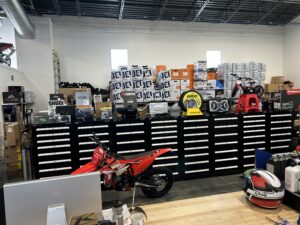A Comprehensive Consider Bike Components: What Every Cyclist Needs To Know
An extensive understanding of motorcycle components is not merely valuable yet essential for any kind of rider intending to take full advantage of performance and security. Each element, from the engine's complex workings to the reliability of brake systems, plays a crucial role in the overall experience and capability of the bike. Beyond just recognizing what these parts do, it is crucial to appreciate how they engage and sustain one another. This interconnectedness can make the difference in between a smooth trip and unexpected problems. What details lie within this mechanical harmony that every cyclist should understand?
Recognizing the Engine
The engine, usually considered the heart of a motorbike, is an intricate setting up of elements that operate in harmony to convert fuel right into activity. At its core, the engine's primary feature includes the combustion process, where air and gas mix and fire up within the cylinders, leading to regulated surges that drive the pistons. These pistons relocate up and down, converting chemical power into power, which ultimately turns the crankshaft, inevitably powering the bike.

Recognizing the ins and outs of a bike engine is crucial for fanatics and riders alike. It not just gives insight right into how bikes accomplish their outstanding power and rate however also aids in efficient maintenance and troubleshooting, ensuring long life and dependability when traveling.
Suspension Equipments
While the engine powers the motorbike, the suspension system plays an important role in making certain a controlled and smooth adventure. The shock absorber is accountable for taking in shocks from the roadway surface, maintaining tire get in touch with, and offering security during cornering and braking. It makes up 2 main components: the front forks and the back shock absorbers.
Front forks are usually telescopic, wetting and including a spring device. The springtime prolongs and compresses to absorb bumps, while the moistening system regulates the movement to protect against excessive bouncing. This mix makes sure the front wheel remains touching the road, offering premium handling and comfort.
The back suspension, usually a monoshock or twin-shock configuration, works in a similar way to the front suspension yet is tailored to support the motorbike's weight and rider - motocross gear nz. It takes care of back wheel movement, adding to the bike's general balance and responsiveness
Suspension systems can be adjustable, permitting motorcyclists to make improvements preload, compression, and rebound settings according to personal preferences and riding conditions. This adjustability boosts efficiency by enhancing the motorbike's communication with diverse surfaces. In summary, an effective suspension system is important for cyclist convenience, safety, and the bike's handling prowess.
Brake Elements
Quiting power is an essential element of motorbike safety, and it pivots on the efficiency of the brake parts. The key aspects of a motorbike's blog braking system consist of the brake pads, calipers, blades, and master cylinder. mx parts nz. Each of these components plays a critical function in making certain reliable stopping efficiency
Brake pads are necessary as they develop the needed friction against the rotors to reduce down or stop the motorbike. Created from materials such as sintered metal or natural compounds, the choice of brake pad material dramatically influences efficiency and longevity. this Calipers, real estate the brake pads, apply stress to the pads when the brake lever is involved, promoting contact with the rotors.
The rotors, generally made from stainless-steel or cast iron, are installed to the wheels and work as the surface area versus which the brake pads press. Their design, consisting of diameter and density, affects heat dissipation and quiting power. The master cylinder, linked to the brake lever, generates hydraulic stress transmitted with brake lines to the calipers, making certain constant braking pressure.
Regular upkeep and inspection of these elements are important for optimal performance, stopping wear and making sure rider safety on the roadway.
Tire Essentials
Beyond preserving durable stopping systems, guaranteeing optimum tire efficiency is equally substantial for bike security and performance. Tires are the sole contact factor in between the motorcycle and the roadway, making their problem pivotal in handling, stability, and general experience top quality.

Inspect the sidewall for the DOT (Division of Transportation) code to identify the tire's age. Investing focus in these tire basics not just enhances performance yet additionally dramatically boosts riding safety and security.
Electric Systems
In the realm of motorbike maintenance, the electrical system plays a vital duty in making sure reliable efficiency and cyclist safety. This complex network incorporates vital elements such as the battery, generator, starter motor, and wiring harness. Each component is essential for the seamless operation of the bike, from ignition to illumination and interaction with numerous sensing units.
The battery works as the heart of the electric system, providing the required power to begin the engine and run devices. Frequently inspecting the battery's voltage and terminals for deterioration is essential to stop unanticipated failures. The alternator, on the various other hand, reenergizes the Web Site battery while the engine is running, making sure a continual power supply.
To preserve it, cyclists should pay attention to any kind of uncommon sounds or troubles throughout start-up. Guaranteeing that the wires are undamaged and totally free from damage is essential for ensuring and stopping short circuits functionality.
Conclusion

Stopping power is a fundamental facet of motorcycle safety, and it hinges on the performance of the brake parts. The main components of a bike's stopping system consist of the brake pads, calipers, rotors, and master cylinder.Brake pads are essential as they create the essential rubbing versus the blades to slow down or quit the motorcycle.Beyond keeping durable stopping systems, making sure ideal tire performance is just as significant for motorcycle safety and security and effectiveness.In the realm of motorcycle upkeep, the electrical system plays a vital function in making certain reliable efficiency and cyclist security.
Comments on “Your Go-To Motorbike Shop for High Quality Parts and Accessories”